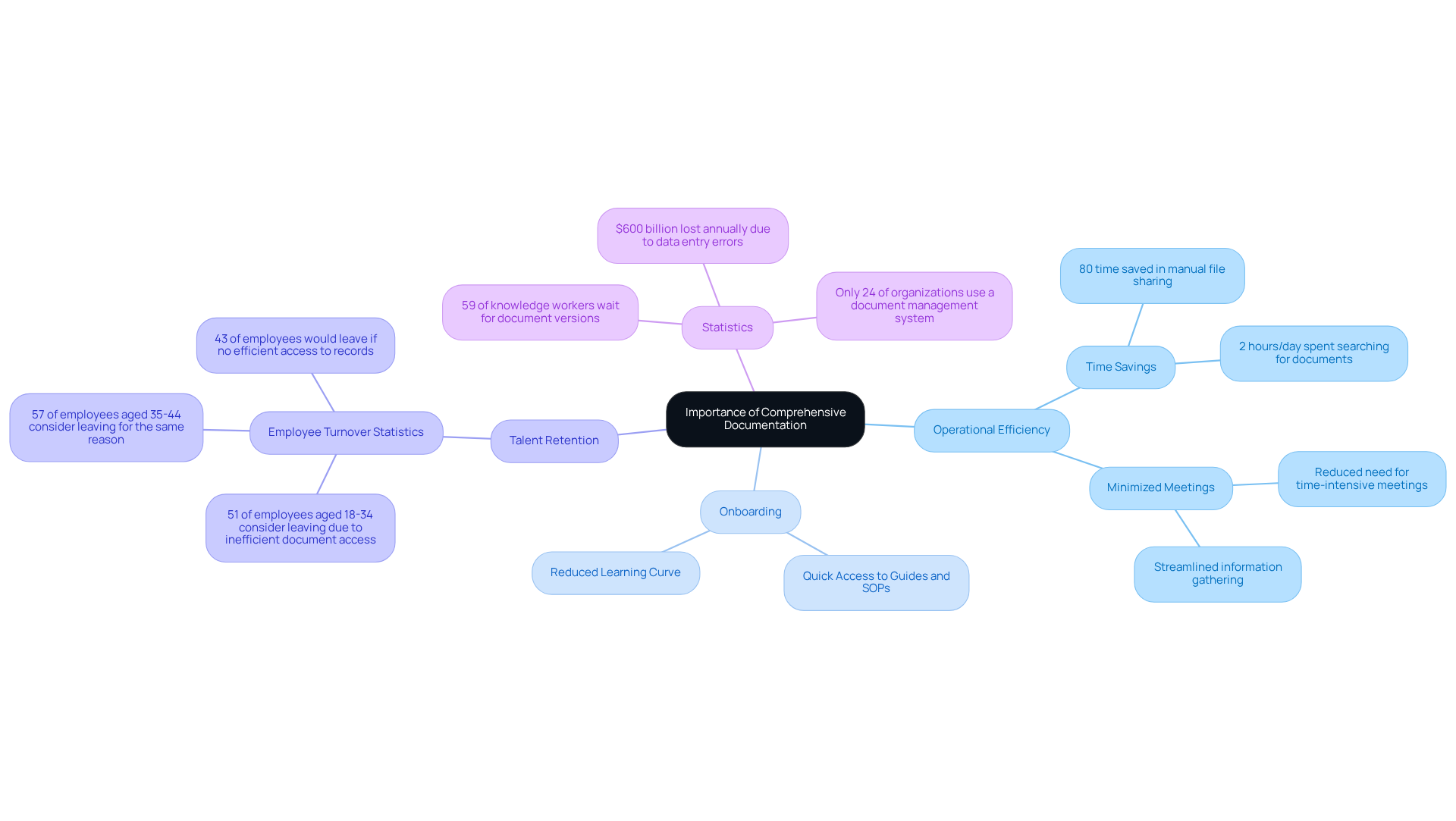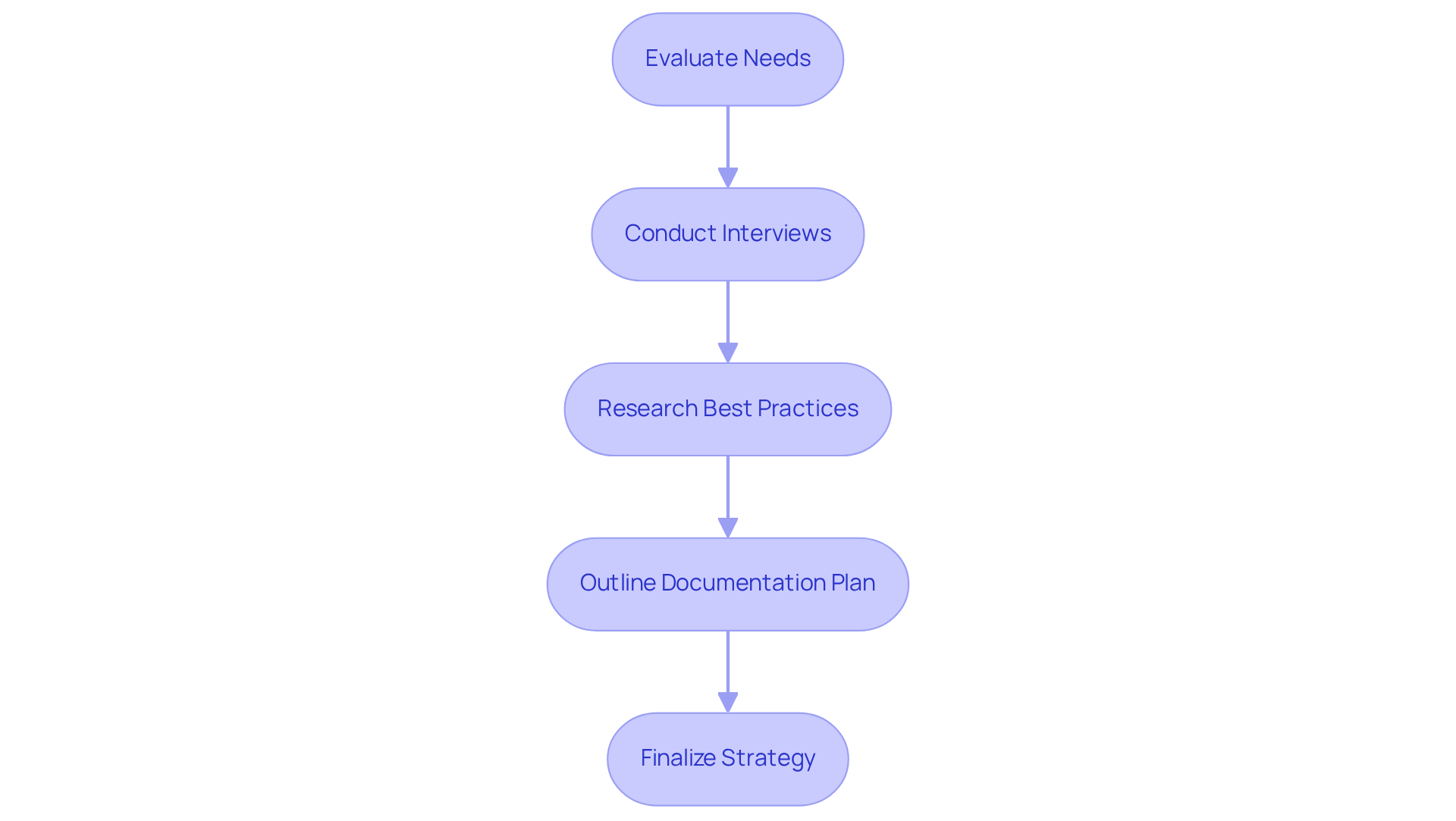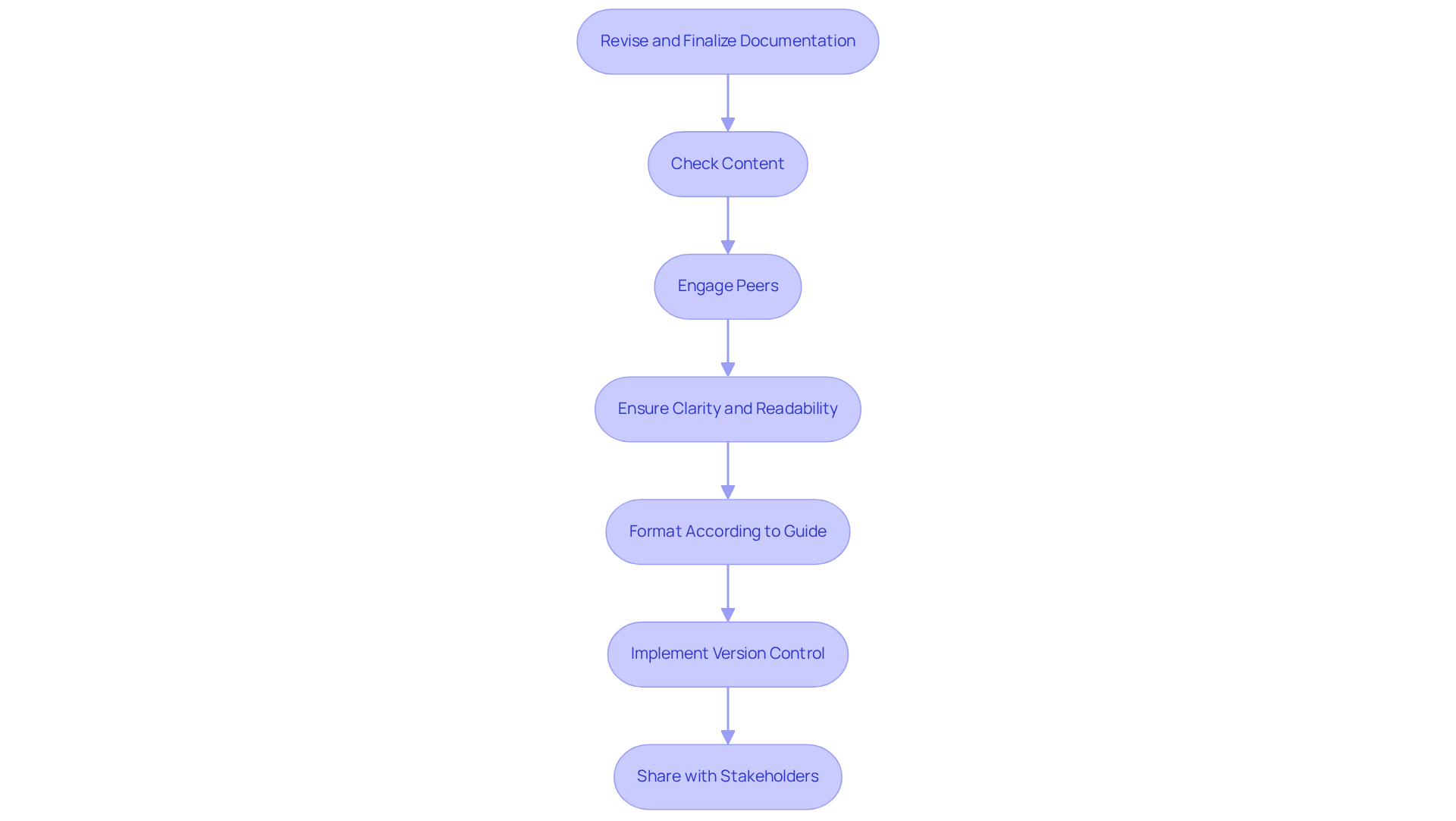
Overview
You might be wondering why creating a comprehensive guide for effective documentation is so important. Well, thorough record-keeping can really boost operational efficiency and employee satisfaction! In fact, did you know that efficient documentation can save organizations up to 80% of the time usually wasted on manual file sharing? That’s a significant amount of time that could be better spent elsewhere.
Now, let’s dive into the challenges many companies face. About 90% of organizations struggle with versioning issues, which is where structured records come into play. By having a solid documentation strategy, you can tackle these challenges head-on. So, why not take a closer look at how effective documentation can transform your workplace? It’s definitely worth exploring!
Key Highlights:
- Comprehensive documentation is essential for operational efficiency, reducing time spent on repetitive tasks and meetings.
- Effective record-keeping can save organisations up to 80% of time typically wasted on manual file sharing.
- 90% of companies face versioning challenges, highlighting the need for efficient record-keeping strategies.
- Thorough records aid in onboarding by providing new employees with guides and SOPs, reducing their learning curve.
- 51% of employees aged 18-34 and 57% of those aged 35-44 would consider leaving jobs due to inefficient document access.
- Americans spend an average of two hours daily searching for files, indicating poor record-keeping practises.
- A strategic approach to documentation involves evaluating needs, researching best practises, and outlining a plan.
- Organised records foster collaboration and improve productivity, with Fortune 500 companies losing $12 billion annually due to unstructured document management.
- Revising and finalising documentation ensures accuracy and completeness, with peer evaluations improving quality.
- 85% of employees feel unsure about the accuracy of externally shared information, stressing the need for clear documentation.
- 90% of businesses struggle to find the latest version of files, indicating the necessity of a version control system.
Introduction
You might be wondering why effective documentation is so crucial for successful organizations. Well, it often serves as the backbone that holds everything together! Comprehensive records can really streamline operations and boost knowledge sharing, making onboarding a breeze and ultimately leading to increased productivity. But here’s the kicker: a staggering 90% of companies face versioning challenges, and employees waste hours just searching for files.
So, how can organizations tackle these issues and develop a documentation strategy that truly transforms their workflow? Let’s dive into that!
Understand the Importance of Comprehensive Documentation
You might be wondering why thorough records matter so much. Well, they’re crucial for any entity! They serve as a solid foundation that ensures important information is easy to find and consistently used. By cutting down the time spent on repetitive tasks and minimizing those never-ending meetings, you can really boost operational efficiency. This structured approach also encourages a culture of knowledge sharing, letting team members rely on documented processes instead of just verbal communication. For example, organizations that embrace effective record-keeping can save up to 80% of the time usually wasted on manual file sharing—talk about a streamlined workflow! And did you know that 90% of companies struggle with versioning challenges? That really highlights the need for efficient record-keeping strategies.
Now, let’s talk about onboarding new employees. Thorough records play a vital role here, too! With established guides and standard operating procedures (SOPs) at their fingertips, newcomers can quickly get up to speed with their roles and responsibilities, reducing the learning curve and boosting productivity right from day one. Statistics show that:
- 51% of employees aged 18-34 would think about leaving their jobs due to inefficient document access.
- 57% of employees aged 35-44 would consider leaving for the same reason.
- 43% of employees would consider jumping ship if their company didn’t have a good way to access necessary records.
This really drives home the importance of efficient record-keeping in keeping talent around.
Ultimately, a comprehensive guide that includes thorough records doesn’t just aid in better decision-making; it also creates a more structured operational framework. By allowing teams to access precise information quickly, companies can tackle challenges more effectively. In today’s fast-paced work environment, thorough records are an invaluable resource. Speaking of which, Glean.com highlights that Americans spend an average of two hours a day searching for files. That’s a lot of time wasted due to poor record-keeping! And with only 24% of entities currently using a management system, there’s a huge opportunity for improvement in how we handle records.

Research and Plan Your Documentation Strategy
You might be wondering how to develop an effective record-keeping strategy for your organization. Well, it all starts with evaluating your needs! Take a moment to identify the key processes that need recording and think about who will be using these materials. Have you considered chatting with your team members? Conducting a few interviews can really help you gather insights on their record-keeping needs and preferences.
Now, let’s dive into some research! Look into best practices in record-keeping that are relevant to your industry. This could mean checking out what your competitors or industry leaders are doing. Once you’ve gathered enough details, it’s time to outline your plan. Think about the types of documents you’ll create, the formats they’ll take, and set a timeline for when you want to complete everything.
By taking this strategic approach, you’ll ensure that your documentation serves as a comprehensive guide that is not only user-friendly but also perfectly aligned with your organizational goals. Sounds good, right?

Draft and Structure Your Comprehensive Guide
You might be wondering where to start in order to create an effective comprehensive guide. Begin by outlining the details you gathered during the planning phase. Organize your content into distinct sections and subsections, using descriptive headings that clearly indicate the focus of each part. This structure not only helps with navigation but also boosts user comprehension. Think about incorporating bullet points, numbered lists, and tables to simplify complex information, making it easier to digest. Each section should kick off with a brief introduction that sets expectations for the reader.
Clarity and conciseness are key here; try to avoid jargon unless absolutely necessary. Visual aids, like diagrams or screenshots, can significantly enhance understanding by illustrating key points. Consistency in language and tone is crucial, ensuring that the text reflects your entity’s voice.
Now, let’s dive into some eye-opening statistics that highlight the importance of clear record-keeping practices:
- Did you know that 90% of companies run into versioning problems, often due to vague headings and structure?
- Furthermore, Fortune 500 companies lose an average of $12 billion each year due to inefficiencies stemming from unstructured document management.
By establishing organized records, organizations can develop a comprehensive guide to tackle these challenges head-on, leading to improved productivity and collaboration. Engaging record-keeping practices not only streamline processes but also foster a culture of collaboration, ultimately maximizing business results.

Revise and Finalize Your Documentation
You might be wondering why revising and finalizing records is such a big deal. Well, it’s a crucial step that serves as a comprehensive guide to ensure everything is accurate and complete. Start by carefully checking the content to spot any missing details or inconsistencies. Engaging a peer in this process can serve as a comprehensive guide, as fresh perspectives often catch errors that might slip past you. Plus, peer evaluations act as a comprehensive guide that boosts precision and enhances the overall quality of the materials by encouraging collaborative input and diverse viewpoints.
Now, let’s discuss clarity and readability as outlined in the comprehensive guide during the revision phase. A comprehensive guide that simplifies complex sentences and clearly explains technical terms can make a huge difference in how well people understand the information. Did you know that 85% of employees feel unsure about the accuracy of information shared externally? That’s a strong reminder of why having a comprehensive guide for clear records is essential. And if that’s not enough, consider that 46% of SMB employees waste time on inefficient paper processes every single day, which really highlights the broader implications of poor documentation practices.
Once you’ve made those revisions, it’s time to format the file in accordance with your organization’s comprehensive guide. Consistency in fonts, headings, and spacing is key! A comprehensive guide on implementing a version control system is also a must for tracking changes and updates over time. A whopping 90% of businesses report struggles in finding the latest version of files, so this system not only helps preserve content integrity but also boosts collaboration by allowing multiple users to work on the same file simultaneously. And here’s a kicker: 83% of employees have to recreate missing documents, which shows just how critical effective record-keeping is.
After you wrap up the paperwork, don’t forget to share it with the relevant stakeholders and provide some training on how to access and use the materials efficiently. This approach acts as a comprehensive guide that not only makes onboarding smoother but also nurtures a culture of continuous improvement and knowledge sharing within the organization. As Mark Fairlie puts it, 'Ninety-one percent of data professionals say data quality issues hurt company performance,' which really underscores the importance of a comprehensive guide for accuracy in documentation and its impact on overall business success.

Conclusion
Creating a comprehensive guide for effective documentation is super important for boosting organizational efficiency and building a culture of sharing knowledge. You might be wondering how thorough record-keeping strategies can help. Well, they can streamline workflows, improve onboarding processes, and really enhance decision-making capabilities. Plus, focusing on structured documentation not only helps keep talent but also tackles the usual challenges of managing information effectively.
As we wrap up, let’s highlight some key insights about the need for a solid documentation strategy. From grasping why comprehensive records matter to drafting, revising, and finalizing documents, every step plays a part in making the workplace more organized and efficient. Did you know that poor documentation practices can lead to wasted time and lost revenue? It’s a staggering reality that underscores why businesses must prioritize effective record-keeping.
In a world overflowing with information that can feel unmanageable, taking steps to improve documentation practices can lead to some serious benefits. Organizations should take a moment to assess their current strategies, adopt best practices, and create an environment where clear communication and easy access to information are key. By doing this, they not only boost productivity but also set themselves up for long-term success in a competitive landscape. So, what are you waiting for? Let’s dive into enhancing those documentation practices!
Frequently Asked Questions
Why is comprehensive documentation important for organizations?
Comprehensive documentation is crucial as it ensures important information is easy to find and consistently used, boosts operational efficiency, and encourages a culture of knowledge sharing.
How does thorough record-keeping improve operational efficiency?
It reduces the time spent on repetitive tasks and minimizes unnecessary meetings, allowing organizations to save up to 80% of the time usually wasted on manual file sharing.
What challenges do companies face regarding document versioning?
Approximately 90% of companies struggle with versioning challenges, highlighting the need for efficient record-keeping strategies.
How do thorough records assist in onboarding new employees?
Established guides and standard operating procedures (SOPs) help newcomers quickly understand their roles and responsibilities, reducing the learning curve and boosting productivity from day one.
What percentage of employees would consider leaving their jobs due to inefficient document access?
Statistics show that 51% of employees aged 18-34, 57% of employees aged 35-44, and 43% of employees overall would consider leaving their jobs for this reason.
What benefits does a comprehensive guide with thorough records provide?
It aids in better decision-making and creates a structured operational framework, allowing teams to access precise information quickly to tackle challenges effectively.
How much time do Americans spend searching for files due to poor record-keeping?
Americans spend an average of two hours a day searching for files, indicating significant time wasted due to inadequate record-keeping.
What percentage of entities currently use a management system for records?
Only 24% of entities are currently using a management system, suggesting a significant opportunity for improvement in record handling.
👍
What others are liking
5 Steps to outline your ideal documentation structure
5 MINS READ
Where to start the your journey of mapping out your ideal documentation structure, aligning it with the very heartbeat of your organization?
Defining a winning level of detail in your process
3 MINS READ
What is too much detail, and what is too little? This article described in that winning level detail about what detail is enough.





